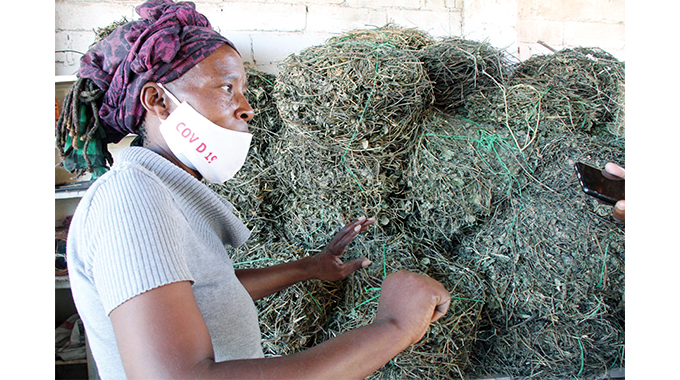Couple sets tone in fodder farming project

Mashudu Netsianda, Senior Reporter
THEIR faces beaming with joy, Mr Enias Dube (65) and his 55-year-old wife, Rita, could not hide their excitement as they showed off 200 bales of fodder crops harvested from their field at Mbuyazwe area in Umguza District, Matabeleland North.
Fodder farming is alien to most cattle owners in the country, especially newly empowered farmers that got land from the Government.
For such farmers, cattle eat available natural growing grass or they buy stockfeed.
Since 2015, the country has lost a total of 154 517 cattle worth US$61 million due to drought, while an average of 30 903 cattle valued at about US$15 million die of drought every year.
The Dubes proudly told Chronicle that their harvest will be used for forage, providing the much-needed protein source for cattle during the next dry period.
Mr Dube and his wife are the pilot lead farmers in Umguza District for the growing of highly nutritious fodder under the Beef Enterprise Strengthening and Transformation (BEST) programme, a joint programme between Government, the European Union (EU) and other partners.
The project seeks to create a robust, competitive beef value chain that promotes enhanced trade, employment creation, food security and inclusive green economic growth for 25 000 small-to-medium as well as commercial cattle farmers in line with Vision 2030.
The project seeks to equip smallholder farmers with skills to improve crop and livestock production. It is targeting 24 900 small to medium cattle producers in the 10 districts.
The districts benefiting under the programme are: Umguza, Lupane, Chiredzi and Mwenezi, Buhera, Makoni, Mt Darwin, Gokwe South, Shurugwi and Kwekwe.
Mr Dube said they planted 2 hectares of velvet beans, lablab, cowpeas and Bana grass during the last rain season.
“We managed to harvest 200 bales of velvet beans, which we intend to use to supplement feed for our mixed herd of 117 animals from the end of August going to the end of the year. This will save us a lot of money in stock feed cost and also add value to our livestock in the market,” he said.
Mr Dube said the harvest will last nine months.
“We got the inputs under the BEST programme and planted velvet beans, lablab, cowpeas and Bana grass. We planted the crops in October last year and by February velvet beans had matured,” he said.
Mr Dube said lablab is suitably used as fodder for cattle, both as hay, silage or as a green feed using a “cut and carry system” — a feeding system where fresh grass is cut daily and fed to housed cattle throughout the grazing season.

Mrs Dube and her husband Enias show fodder and the grinding machine.
“When lablab is grazed, it is mostly the leaves that get eaten and the stems are left. Since it is a fast grower, it can withstand frequent defoliation under rotational grazing. It is of high forage quality and drought tolerant.”
Lablab has high grain yields and a better root disease resistance than many plants of its species. It grows in a wide range of soils from deep sands to heavy clays and is capable of extracting water from at least a two-metre depth even in heavy textured soils.
Mr Dube said Bana grass is one of the most vital fodder grasses for feeding ruminant in sub-Saharan Africa, mainly due to its high productivity.
“Unlike velvet beans and cowpeas, which we crush and grind to make hay bales, we take Bana grass to the silage pit where we mixed it with other crops such as sorghum, lablab, velvet bean, cowpeas and maize and sprinkle molasses on top. We then compact the mixture using a 200-litre- drum because we don’t have a tractor until the pit is full,” he said.

She explains the use of the pit where they keep the fodder
“We then cover the pit using a plastic paper and put soil on top of it to protect the supplementary feeding from the sun and animals.”
Mrs Dube weighed in: “The silage is stored in the pit for 21 days after which it would be read for feeding the livestock. However, in our case, although the silage is now ready, we are waiting for a period between August-September to feed our cattle.”
She said during the period between August and November, natural pastures lose nutritional value mainly owing to lack of grazing management plans, risk of veld fires and increased exposure to droughts.
“We have plans to commercialise and produce the seeds and sell to other to farmer. This is a laborious exercise and the major challenges is that we don’t have equipment such as a tractor, combine harvest and chopper grinder,” said Mrs Dube.
Matabeleland North chief agronomist Mr Dumisani Nyoni said Government is working with various partners in fodder production.
“Due to recurrent droughts resulting in livestock dying, Government felt there was a need for farmers to reserve some land for fodder production. Even though there is still grass, but the pastures are running out of protein content, which is why such programmes were introduced to mitigate against the effects of droughts,” he said.
Mr Nyoni said the development model is a solution that will resuscitate formal cattle markets and provide timely cattle production services.
“Farmers will realise more value for their livestock which will go a long way to eradicate poverty and increase household incomes. In some cases, we are working with partners to pilot the project and as Agritex we are providing technical expertise,” he said.
“In Umguza, we started the fodder production project under BEST, but now we have just introduced the Presidential Livestock Scheme and Government is assisting with seed packs and fertilisers so that farmers can grow crops and the harvest will be used for forage.”
Mr Nyoni said under the Presidential Livestock Scheme, farmers without cattle will also benefit under the programme dubbed “Creation of Forage Banks” so that they are able to generate incomes through selling fodder.
He said the forage programme will be complemented by a hay cutting and baling programme that will provide the bulk feed.
To mitigate against the effects of drought, the Ministry of Lands, Agriculture, Fisheries, Water and Rural Resettlement through the Department of Livestock Production and Development is implementing the “Creation of Forage Banks” in areas severely affected by drought. — @mashnets.










Comments